|
|
ARTHROPODS:
Insects»
Spiders»
Centipedes»
Millipedes»
Sowbugs»
Harvestmen»
Mites
& Ticks»
Scorpions»
Identification
Tips»
About
the Critter Files»
Links» |
|
|
|
 |
DOBSONFLIES
& FISHFLIES
Critter
Files/Insects/Dobsonflies &
Fishflies
By Blake Newton
University of Kentucky Department of Entomology |
| |
|
| |
| TAXONOMY |
KINGDOM: Animalia
| PHYLUM: Arthropoda | CLASS: Insecta | ORDER: Megaloptera (dobsonflies,
fishflies, and alderflies) |
| |
WHAT
IS A DOBSONFLY?
LIFE CYCLE
ECOLOGY
PEST STATUS
COMMON KENTUCKY DOBSONFLIES
COLLECTING & PHOTOGRAPHY
DOBSONFLY FACTS
MYTHS, LEGENDS, AND FOLKLORE |
| |
| WHAT
IS A DOBSONFLY? |
|
| Like all insects, dobsonflies
and fishflies have 6 legs, 2 antennae, and 3 body parts. Adult
dobsonflies and fishflies are large and have 2 pairs of wings and
chewing mouthparts. They resemble dragonflies,
but dobsonflies and fishflies cannot fly as well as dragonflies. Also,
dobsonflies and fishflies hold their wings over their backs when they
are not flying: dragonflies are unable to fold their wings over their
bodies. Male
dobsonflies have sickle-shaped mandibles that are more than twice
the length of their heads. The mandibles on female dobsonflies
and both male and female fishflies are much shorter. Otherwise,
dobsonflies and fishflies are very similar in appearance, with dobsonflies
generally being larger. Dobsonfly and fishfly larvae are fully
aquatic and resemble wingless adults. They have chewing mouthparts
and 7-8 filaments on the sides of their abdomens. Dobsonfly
and fishfly larvae are often called "hellgrammites."
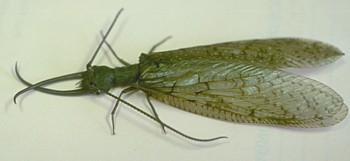
Male Eastern
Dobsonfly (R. Bessin, 2000)
|
|
| SIZE:
Body length of adults and larvae up to 2" long. |
| |
| LIFE
CYCLE |
|
Dobsonflies
and fishflies have complete metamorphosis. After hatching
from eggs, young dobsonflies and fishflies live underwater for several
years before coming to land to pupate. The pupal stage lasts
for the winter and spring, after which the winged-adults emerge.
The adults typically live for only a few days, just long enough
to mate and lay eggs. |
| |
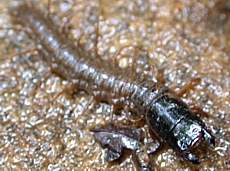 Fishfly Larva
Fishfly Larva
(B. Newton, 2003) |
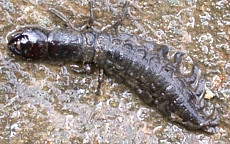 Dobsonfly Larva
Dobsonfly Larva
(B. Newton, 2004) |
| |
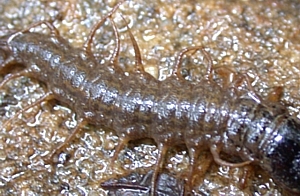 Close-up of filaments
on fishfly larva abdomen (B. Newton, 2003)
Close-up of filaments
on fishfly larva abdomen (B. Newton, 2003) |
| |
 Dobsonfly eggs
attahed to a rock (B. Newton, 2005)
Dobsonfly eggs
attahed to a rock (B. Newton, 2005) |
| |
| ECOLOGY |
|
Dobsonflies
and fishflies live most of their lives in the larval stage, often
2 or 3 years. Larval dobsonflies and fishflies, often called
"hellgrammites", are large, worm-like, aquatic predators
that live under rocks and logs in streams. They feed on minnows,
tadpoles, insects, and other aquatic prey. Hellgrammites require
very clean, unpolluted water to live. Most adult dobsonflies
and fishflies do not feed at all. |
| |
| PEST
STATUS |
|
Dobsonflies
and fishflies are not considered pests. |
| |
| COMMON
KENTUCKY DOBSONFLIES |
|
|
EASTERN
DOBSONFLIES
FAMILY: Corydalidae
| GENUS: Corydalus
cornutus
The Eastern Dobsonfly
is the most commonly encountered dobsonfly in Kentucky. It
is among Kentucky's most distinctive insects and is sought after
by collectors and photographers. Below is a female eastern
dobsonfly: note that her mandibles are much smaller than those of
the male pictured above. |
| |
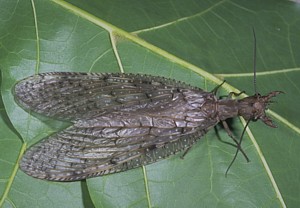 Female Eastern
Dobsonfly (B. Newton, 2002)
Female Eastern
Dobsonfly (B. Newton, 2002) |
|
| |
| COLLECTING
& PHOTOGRAPHY |
|
Dobsonfly and fishfly
adults are a challenge to find because they are only around for
a few weeks each year. Look on rocks and logs near streams
in the early summer. Hellgrammites can usually be found under
rocks year round in clean, fast-flowing streams. Look out,
because they can bite! They are slow-moving, however, and
will usually remain still for a photograph if they are not touched.
|
| |
| DOBSONFLY
FACTS |
|
Although they are not
as sensitive to pollution as stoneflies
and mayflies, hellgrammites
still need clean water to live. Fisherman once commonly used
hellgrammites as fish bait, but polluted streams have made hellgrammites
less common.
Scientists can tell how
polluted a stream is based on what aquatic insect species are present.
Read more about using insects to determine water quality:
http://www.aces.edu/pubs/docs/A/ANR-1167/ANR-1167.pdf
|
| |
| MYTHS
- LEGENDS - FOLKLORE |
|
Dobsonfly larvae go
by several different names, including "hellgrammite,"
"grampus," and "go-devil."
|
Original document: 25 May 2004
Last updated: 19 Dec 2006
Photos courtesy R.
Bessin and B. Newton, University of Kentucky
The Kentucky Critter Files are maintained by Blake Newton, Department
of Entomology, University of Kentucky.
Contact: blaken@uky.edu |
|

